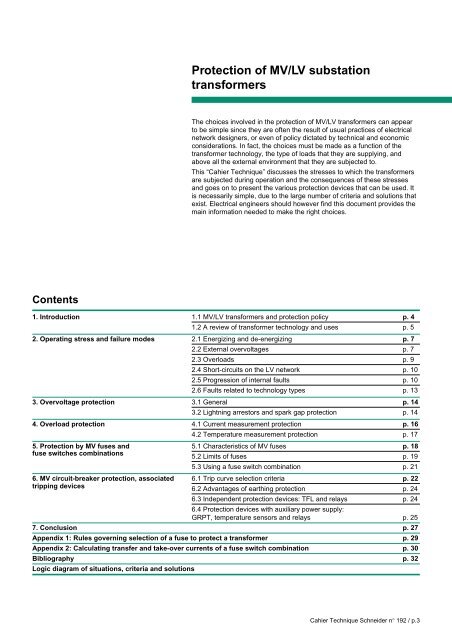ECT192
Create successful ePaper yourself
Turn your PDF publications into a flip-book with our unique Google optimized e-Paper software.
Protection of MV/LV substation<br />
transformers<br />
The choices involved in the protection of MV/LV transformers can appear<br />
to be simple since they are often the result of usual practices of electrical<br />
network designers, or even of policy dictated by technical and economic<br />
considerations. In fact, the choices must be made as a function of the<br />
transformer technology, the type of loads that they are supplying, and<br />
above all the external environment that they are subjected to.<br />
This “Cahier Technique” discusses the stresses to which the transformers<br />
are subjected during operation and the consequences of these stresses<br />
and goes on to present the various protection devices that can be used. It<br />
is necessarily simple, due to the large number of criteria and solutions that<br />
exist. Electrical engineers should however find this document provides the<br />
main information needed to make the right choices.<br />
Contents<br />
1. Introduction 1.1 MV/LV transformers and protection policy p. 4<br />
1.2 A review of transformer technology and uses p. 5<br />
2. Operating stress and failure modes 2.1 Energizing and de-energizing p. 7<br />
2.2 External overvoltages p. 7<br />
2.3 Overloads p. 9<br />
2.4 Short-circuits on the LV network p. 10<br />
2.5 Progression of internal faults p. 10<br />
2.6 Faults related to technology types p. 13<br />
3. Overvoltage protection 3.1 General p. 14<br />
3.2 Lightning arrestors and spark gap protection p. 14<br />
4. Overload protection 4.1 Current measurement protection p. 16<br />
4.2 Temperature measurement protection p. 17<br />
5. Protection by MV fuses and 5.1 Characteristics of MV fuses p. 18<br />
fuse switches combinations<br />
5.2 Limits of fuses p. 19<br />
5.3 Using a fuse switch combination p. 21<br />
6. MV circuit-breaker protection, associated 6.1 Trip curve selection criteria p. 22<br />
tripping devices<br />
6.2 Advantages of earthing protection p. 24<br />
6.3 Independent protection devices: TFL and relays p. 24<br />
6.4 Protection devices with auxiliary power supply:<br />
GRPT, temperature sensors and relays p. 25<br />
7. Conclusion p. 27<br />
Appendix 1: Rules governing selection of a fuse to protect a transformer p. 29<br />
Appendix 2: Calculating transfer and take-over currents of a fuse switch combination p. 30<br />
Bibliography p. 32<br />
Logic diagram of situations, criteria and solutions<br />
Cahier Technique Schneider n° 192 / p.3


